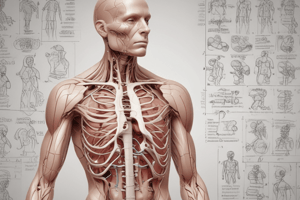Podcast
Questions and Answers
What is the location of the perineum?
What is the location of the perineum?
- Between the ischial tuberosities and pubic symphysis
- Between the coccyx and sacrum
- Between the scrotum and penis
- Between the anus and genital area (correct)
What is the purpose of the pelvic floor muscles?
What is the purpose of the pelvic floor muscles?
- To regulate body temperature
- To facilitate respiration
- To control movement of the limbs
- To support pelvic organs (correct)
What is the function of the perineum in relation to urinary and fecal continence?
What is the function of the perineum in relation to urinary and fecal continence?
- To maintain urinary and fecal continence (correct)
- To stimulate bowel movements
- To compress the urethra
- To relax the anal sphincter
Which muscle is NOT a perineal muscle?
Which muscle is NOT a perineal muscle?
What is the name of the triangle that contains the anus and surrounding muscles?
What is the name of the triangle that contains the anus and surrounding muscles?
What is the role of the perineum in childbirth?
What is the role of the perineum in childbirth?
Flashcards are hidden until you start studying
Study Notes
Anatomy of the Perineum
- Located between the anus and genital area (scrotum in males, vulva in females)
- Diamond-shaped region bounded by the following landmarks:
- Anteriorly: pubic symphysis
- Posteriorly: coccyx
- Laterally: ischial tuberosities
- Medially: anus
Divisions of the Perineum
- Anterior (urogenital) triangle:
- Contains genital organs (penis, scrotum, or vulva)
- Bound by the pubic symphysis, ischiopubic rami, and ischial tuberosities
- Posterior (anal) triangle:
- Contains the anus and surrounding muscles
- Bound by the coccyx, ischial tuberosities, and sacrotuberous ligaments
Muscles of the Perineum
- Pelvic floor muscles:
- Pubococcygeus muscle
- Iliococcygeus muscle
- Puborectalis muscle
- Perineal muscles:
- Bulbospongiosus muscle
- Ischiocavernosus muscle
- Transverse perineal muscle
Functions of the Perineum
- Supports pelvic organs (bladder, uterus, rectum)
- Maintains urinary and fecal continence
- Involved in sexual function and sensation
- Plays a role in childbirth (vaginal delivery)
Studying That Suits You
Use AI to generate personalized quizzes and flashcards to suit your learning preferences.




